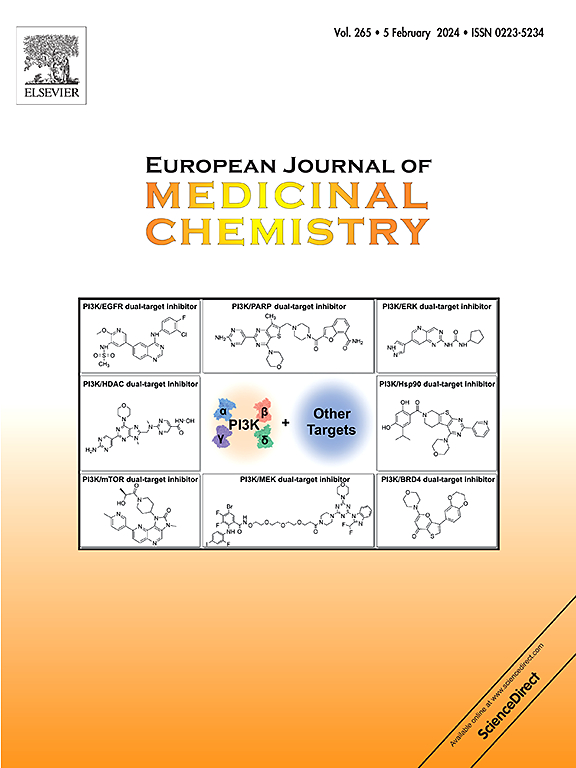Discovery of a potent, broad-spectrum and in vivo effective deuterated tetrazole CYP51 inhibitor
IF 6
2区 医学
Q1 CHEMISTRY, MEDICINAL
引用次数: 0
Abstract
Invasive fungal infections (IFIs) are a serious infectious disease worldwide, characterized by high mortality and morbidity. Azole drugs are the most commonly used drugs for the treatment of invasive fungal infections. However, because azole drugs can easily interact with human CYPs metabolic enzymes, the risk of drug-to-drug interaction is high when multiple drugs are used together with azole drugs in clinic. As the problem of fungal drug resistance is becoming increasingly serious, there is an urgent need to develop new CYP51 inhibitors. The successful marketing of Oteseconazole has brought the development of azole drugs into a new era. Compound A33, previously discovered by our group, showed excellent antifungal activity against a variety of pathogenic and drug-resistant fungi. Nevertheless, owing to its structural characteristics, it showed poor selectivity for the human CYPs family and extremely poor metabolic stability. To address the above problem, inspired by the reduced CYP inhibition observed in Oteseconazole, we replaced its triazole group with tetrazole and attempted deuteration strategies and carbonyl introduction to block the metabolic site. This modification led to the synthesis of compounds V01–V24, in which V23 showed broad-spectrum activity and resistance characteristics, especially against Aspergillus fumigatum (MIC80 = 1 μg/mL), which had no inhibitory activity for many azole drugs. Compared to A33, the introduction of the tetrazole structure reduced its inhibitory activity against the human CYPs family. Furthermore, V23 could prevent fungal phase transformation and biofilm formation, resulting in satisfactory fungicidal activity. V23 showed negligible toxicity toward SH-SY5Y and HUVEC cells, and in vivo pharmacodynamic studies have shown that V23 has significant in vivo antifungal activity. In conclusion, the discovery of compound V23 is a successful exploration of a new tetrazole CYP51 inhibitor for the treatment of invasive fungal infections.


发现一种有效的、广谱的、体内有效的氘化四唑类CYP51抑制剂
侵袭性真菌感染(IFIs)是世界范围内的一种严重传染病,其特点是死亡率和发病率高。唑类药物是治疗侵袭性真菌感染最常用的药物。但由于唑类药物易与人CYPs代谢酶相互作用,临床上多种药物与唑类药物合用时发生药物间相互作用的风险较高。随着真菌耐药问题的日益严重,迫切需要开发新的CYP51抑制剂。奥特斯康唑的成功上市,使唑类药物的发展进入了一个新的时代。化合物A33是本课课组此前发现的化合物,对多种病原菌和耐药真菌具有良好的抗真菌活性。然而,由于其结构特点,其对人类CYPs家族的选择性较差,代谢稳定性极差。为了解决上述问题,受奥替康唑对CYP抑制作用降低的启发,我们用四唑取代了它的三唑基团,并尝试了氘化策略和引入羰基来阻断代谢位点。该修饰得到化合物V01-V24,其中V23具有广谱活性和耐药特性,特别是对烟曲霉(MIC80 = 1 μg /mL),对多种唑类药物无抑制活性。与A33相比,四唑结构的引入降低了其对人类CYPs家族的抑制活性。此外,V23还能抑制真菌的相变和生物膜的形成,具有良好的杀真菌活性。V23对SH-SY5Y和HUVEC细胞的毒性可忽略不计,体内药理学研究表明V23具有显著的体内抗真菌活性。综上所述,化合物V23的发现是一种治疗侵袭性真菌感染的新型四唑类CYP51抑制剂的成功探索。
本文章由计算机程序翻译,如有差异,请以英文原文为准。
求助全文
约1分钟内获得全文
求助全文
来源期刊
CiteScore
11.70
自引率
9.00%
发文量
863
审稿时长
29 days
期刊介绍:
The European Journal of Medicinal Chemistry is a global journal that publishes studies on all aspects of medicinal chemistry. It provides a medium for publication of original papers and also welcomes critical review papers.
A typical paper would report on the organic synthesis, characterization and pharmacological evaluation of compounds. Other topics of interest are drug design, QSAR, molecular modeling, drug-receptor interactions, molecular aspects of drug metabolism, prodrug synthesis and drug targeting. The journal expects manuscripts to present the rational for a study, provide insight into the design of compounds or understanding of mechanism, or clarify the targets.

 求助内容:
求助内容: 应助结果提醒方式:
应助结果提醒方式:


